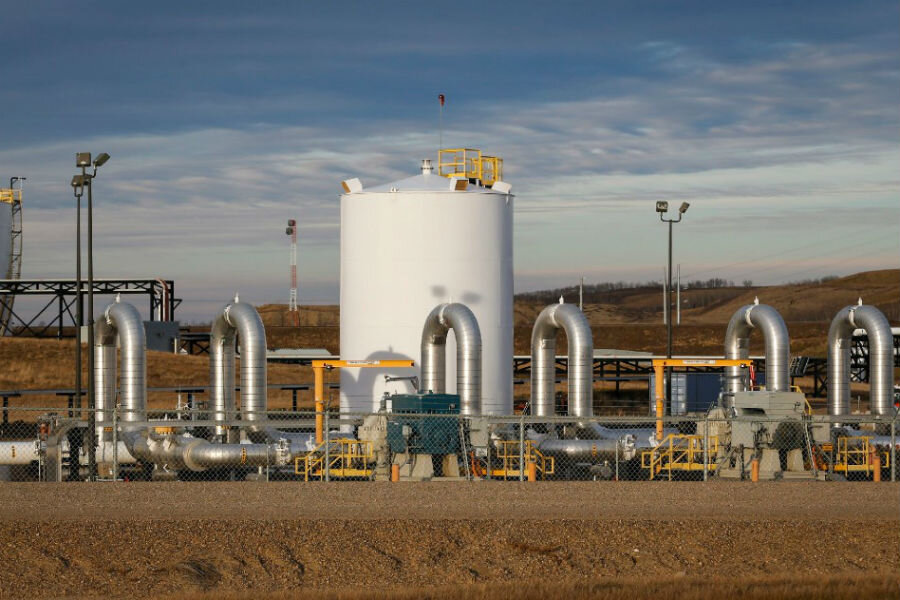Why Keystone XL pipeline won't buy US steel, despite Trump's order
Loading...
From the start of President Trump’s election campaign, two aspects of his political identity – the businessman and the populist – have dueled for dominance. At least in the case of the Keystone XL pipeline, the businessman appears to be winning out.
Speaking to reporters onboard Air Force One on Friday, White House spokeswoman Sarah Huckabee Sanders said that the pipeline, which has been in the works for a decade, will be exempt from an executive order Mr. Trump signed in January requiring new pipelines, repairs, or retrofits to use US steel “to the maximum extent possible.” The justification for that decision: The pipeline is already under construction, and so is not covered by the executive order.
“The Keystone XL Pipeline is currently in the process of being constructed, so it does not count as a new, retrofitted, repaired, or expanded pipeline,” Ms. Sanders said.
As the new administration works to live up to its campaign promises of job creation and a strong economy, some see the pipeline decision as a triumph of business-friendly ideas – like open economies – over populist calls to “buy American and hire American.”
“The value of a pipeline is that we have a pipeline that can be used. Which steel it is made from is an entirely subsidiary question,” wrote Forbes contributor Tim Worstall, senior fellow at the Adam Smith Institute, in an opinion piece. “And if American steel is best to use then use that, if not American is better then use that instead. What we want is the pipeline that can be used at the least overall cost.”
The Keystone XL pipeline was first proposed by developer TransCanada in 2008, and has made sporadic construction progress in the decade since. The Obama administration rejected the project, which would carry bitumen from the oilsands of Alberta to refineries on the Gulf Coast of the US, on environmental grounds in 2015. But in January, an executive order by Trump smoothed the way for construction on the pipeline to recommence. (The southern section of the pipeline, which does not cross an international border and so did not require State Department approval, is already operational.)
Allowing the pipeline to go forward was a way for Trump to live up to the pro-business pledges he made on the campaign trail, while improving American infrastructure. Keystone added $5.7 billion to the economies of Oklahoma and Texas while the southern leg of the pipeline was under construction, according to the Institute for Energy Research, a Washington, DC-based nonprofit focused on energy research.
From ports to pipelines, Trump’s promised infrastructure upgrades were some of the most compelling features of his platform on the campaign trail. A January Gallup poll found that support for revitalizing infrastructure ran far higher among the American public than any of Trump’s other campaign issues, with 69 percent of respondents rating it “very important.”
And his business experience, Trump stressed, would allow him to rebuild America where other presidents had stumbled.
“Construction is what I know,” Trump said over the summer, speaking from his hotel in New York City. “Nobody knows it better.”
But construction on the pipeline was threatened by Trump’s populist program, encapsulated in the phrase, “Buy American and hire American.” His January 24 executive order, which called for all new pipelines to be built using American steel, would have slowed progress and increased costs for the project.
With that in mind, the Trump administration appears to have rolled back Trump’s initial statement that the executive order would apply to Keystone, too.
“The steel is already literally sitting there” waiting to be used, White House spokeswoman Sanders told reporters, explaining the reversal. Evraz Steel, a Canadian subsidiary of Russia’s Evraz PLC, had signed on to provide 24 percent of the steel before the project was rejected under Obama, according to Reuters, and some pipe segments have already been built.
For supporters like Mr. Worstall, the move is a win for business and good economics – and may provide a lesson for the future.
“We are made richer in aggregate by using the cheapest inputs into any project,” he writes. “There should therefore be no insistences on using American steel in any pipeline, not just this one.”
The Canadian government also lauded the decision, with Prime Minister Justin Trudeau’s office calling it a "recognition that the integrated Canadian and US steel industries are mutually beneficial."
But the move may be more a temporary demonstration of pragmatism than a sign of a shift in course. In addition, Politico suggested that allowing Keystone XL to go forward might persuade TransCanada to drop a $15 billion NAFTA complaint against the US, which it brought after construction was suspended earlier this week. And American steel will be a feature of future pipelines, Sanders emphasized.
“Everything moving forward would fall under that executive order," she said.
Material from Reuters was used in this report.
[Editor's note: This article has been edited to clarify Mr. Worstall's title.]








